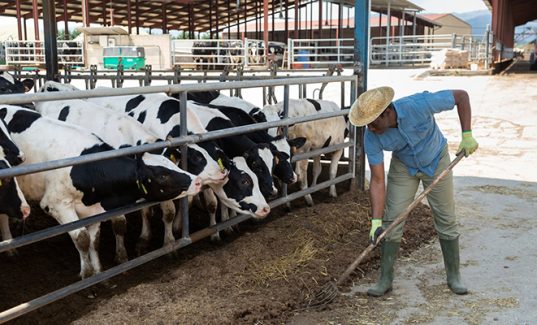With the cost of raising calves and heifers being the second largest expenditure category on most dairy farms and with profit margins being tight today, it might be appropriate to consider if some of those calves and heifers should be culled or be fed as beef animals.
How to make such decisions was the topic for Fond du Lac County dairy and livestock agent Tina Kohlman at the Extension Service dairy team’s 2017 program on raising quality dairy heifers. In addition to the criteria which exist on a particular dairy farm, she said some general guidelines deserve consideration.
Cost considerations
Regarding the raising costs for dairy cattle, Kohlman cited the on-farm averages from the 2015 survey overseen by Extension Service agents on the state-wide dairy team. Those costs were $375 per dairy calf at the time of weaning before being moved to group housing and another $1,730 from then until calving
While acknowledging that buying replacement springing heifers is not a preferred ownership or management choice at many dairy operations, Kohlman pointed out that there were considerable cost savings in purchasing those animals in early March of this year.
At the Equity Cooperative livestock markets in Reedsville and Stratford, the price range was $1,000 to $1,650 for dairy heifers in their 5th to 9th month of pregnancy, Kohlman noted. Prices were somewhat higher across the board in Pennsylvania, Kentucky, and Missouri but all were at least $250 below the $2,000 plus cost indicated by the 2015 survey in Wisconsin, she observed.
Historical heifer inventory
New heifer inventory heights have been reached in terms of the percentage of heifers compared to cows in the nation’s milking herd, Kohlman stated. The January dairy heifer inventory of 4.75 million head was 51 percent of the total of lactating cows compared to a percentage of 36 in 1977, she noted.
Of the January 2017 dairy replacement inventory, California had 760,00 head and Wisconsin 710,000, Kohlman reported. She attributed a portion of those totals to the strong belief that all heifer calves should be kept rather than having some of them be top candidates for culling.
How many heifers are needed can be determined by the known culling rate of the milking herd and whether selling replacement heifers is a practice on the farm, Kohlman observed. Beyond that, she said the pertinent question is whether some of the calves or heifers being raised should be culled instead.
Culling cycle windows
Based on the approximately 675 to 730 days for raising a dairy replacement animal who calves at 22 to 24 months, there are primary culling opportunities at weaning, during the nearly 300 days during the pre-breeding growth phase, and at breeding, Kohlman suggested.
Whatever the point on that timetable, growth rates, often based on health problems, could well be the determining factor, Kohlman remarked. That’s why having and using good health records on every calf is important, she advised.
For culling at weaning, a calf’s history of pneumonia or other respiratory ailments could be reason enough to cull while a bout of diarrhea is usually less serious, Kohlman pointed out. She cited numerous research studies which show much higher risks with reproduction, reduced milk and components production, and earlier culling as a result of calfhood illnesses.
During the pre-breeding or growth phase of close to 300 days, Kohlman mentioned an ideal daily weight gain of 1.75 (range of 1.6 to 1.8 pounds) as an excellent criterion for evaluating a dairy heifer’s prospects. To verify that, weigh a representative sample of the heifer group, identify those which are lagging, and make a decision on their fate, she suggested.
Losses due to delays
At the time for breeding, it’s likely that $1,300 has already invested in the heifer, Kohlman pointed out. If there were health treatment costs along the way, it would be even more, she added.
If there is a delay in breeding due to lagging growth or health-related problems, research studies continue to show that calvings at older than 25 months result in reduced milk production during the first and later lactations, Kohlman indicated.
As shown in an accumulation of records for 200,000 cows in 34 herds, poor conception rates as heifers carry over to a series of reproductive problems later, Kohlman pointed out. The bottom line in all of those scenarios is to cut one’s losses early, whether due to actual performance of heifers or based on genomic testing of calves, she observed.
In the right situations on management and facilities, there could an opportunity to raise dairy heifers for beef instead, Kohlman concluded.
Source: Wisconsin State Farmer




